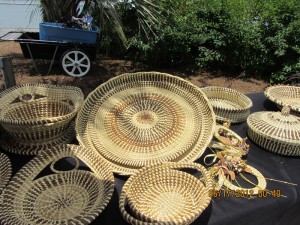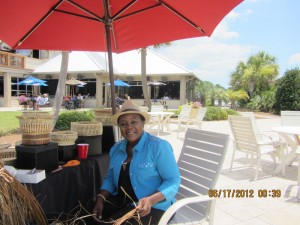On my first trip to the Lowcountry some years ago, I fell in love with the sweetgrass baskets made by the Gullah women of Mt. Pleasant and the sea islands. I still remember watching an elderly artisan at work outside the old Kiawah Island Inn, which has since been torn down. Using a flattened spoon handle as a kind of awl, she wove elaborate baskets of all shapes and sizes from native materials including palmetto, long pine needles, bulrush and sweetgrass, carrying on a tradition brought here almost 400 years ago.
 When the slaves of West Africa arrived, they continued their beautiful art form, making baskets that served a variety of purposes on the rice plantations they were brought to serve. Many plantation mistresses had a sweetgrass basket for holding keys to her storerooms, smokehouses and other outbuildings. Large, flat baskets called “fannahs” were used to make the chore of fanning rice easier. Today the weaving of sweetgrass baskets is one of the oldest surviving art forms in the U S.
When the slaves of West Africa arrived, they continued their beautiful art form, making baskets that served a variety of purposes on the rice plantations they were brought to serve. Many plantation mistresses had a sweetgrass basket for holding keys to her storerooms, smokehouses and other outbuildings. Large, flat baskets called “fannahs” were used to make the chore of fanning rice easier. Today the weaving of sweetgrass baskets is one of the oldest surviving art forms in the U S.
From Charleston, Highway 17 north, toward Georgetown, or south, toward Savannah is dotted with simple wooden stalls where these artisans sell their creations. I love seeing the great variety of sizes and materials, and the sometimes whimsical forms these Gullah ladies weave. Ron and I hang out at Bohicket Marina, near our beach rental on Kiawah. We go there for lunch at the Rosebank Farms Cafe or Red’s Ice House, and then stroll down to the far end of the marina for ice cream, taking in the sight of hundreds of boats moored there, watching fishing boats coming and going.
 This trip, I was lucky enough to meet another sweetgrass artisan who had set up shop at the marina. She was kind enough to pose for this photo, and to allow me to photograph her work. She told me the large basket in the photo took more than two months to complete. She also said it’s getting harder each year to find enough materials for weaving, as more and more of the coastal areas fall into private hands.
This trip, I was lucky enough to meet another sweetgrass artisan who had set up shop at the marina. She was kind enough to pose for this photo, and to allow me to photograph her work. She told me the large basket in the photo took more than two months to complete. She also said it’s getting harder each year to find enough materials for weaving, as more and more of the coastal areas fall into private hands.
Another thing that has changed since I bought my first basket all those years ago: prices have dramatically increased. Not that they were ever inexpensive, but now some of them sell for thousands of dollars. In an interview, another basket maker, Nakia Wigfall, reminded me that a sweet grass basket is more than simply a container or something to be set on a shelf, it’s a tangible expression of the things that make the Lowcountry so captivating and haunting: its tortured history, long traditions, and rich culture that set it apart from anywhere else. That is something worth preserving. And worth paying for.